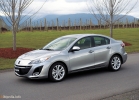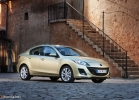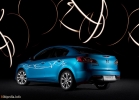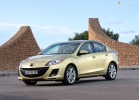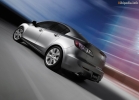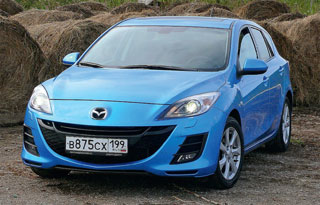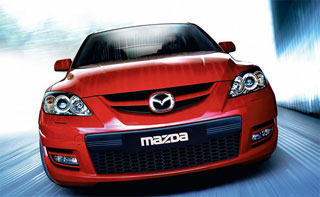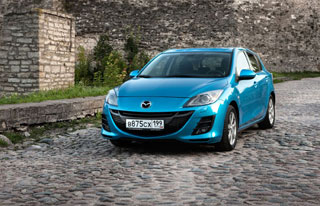Test drive Mazda Mazda 3 (Axela) Sedan since 2009 sedan
Mazda 3

Taste for life
 Previous Mazda models were good cars, but nothing more. They were quite reliable, quite comfortable, but boring, like bank clerks. In a word, they were best suited for people who only need to go to work from the car without much trouble and inconvenience. The six painted this gray world with bright colors, filling it with emotions arising from communicating with her. But, as you know, the sign of real skill is stability. And therefore, the appearance of the triples were looking forward to. Will she be as good as her older sister, or is the six only an episode?
Previous Mazda models were good cars, but nothing more. They were quite reliable, quite comfortable, but boring, like bank clerks. In a word, they were best suited for people who only need to go to work from the car without much trouble and inconvenience. The six painted this gray world with bright colors, filling it with emotions arising from communicating with her. But, as you know, the sign of real skill is stability. And therefore, the appearance of the triples were looking forward to. Will she be as good as her older sister, or is the six only an episode? Cost selection
It is good that the Japanese refused to unify body panels. Of course, this could significantly reduce the cost of preparing production, but how terrible there are hatchbacks with welders welded to them. Mazda3 The result of a completely different approach. Hatchback and sedan do not have a single common external body panel, all the details from the front to the rear bumper are different. With indisputable external similarities, they are dressed in different style. The hatchback has more stylish, interesting details, and the very shape of the body meets the last fashion. It turned out such a somewhat frantic machine. The sedan looks stricter. He captivates not so much interesting details as a harmonious, finished form, which is supported by smooth, clean lines. Even the car standing on the spot seems
 swiftly flying forward. The only thing that spoils the appearance of the sedan slightly is the trunk opening button located near the rear lamp. Against the background of smooth, beautiful lines, it looks like a completely foreign detail, like the last stroke in the corner of the picture, which the artist did not have enough inspiration, and it was necessary to draw this bar. But this, however, is already a nit -picking.
swiftly flying forward. The only thing that spoils the appearance of the sedan slightly is the trunk opening button located near the rear lamp. Against the background of smooth, beautiful lines, it looks like a completely foreign detail, like the last stroke in the corner of the picture, which the artist did not have enough inspiration, and it was necessary to draw this bar. But this, however, is already a nit -picking. Inside, everything is just like outside, simply, neatly, stylishly and without unnecessary attempts to appear on a class older. A panel with three wells of dashcams, a very convenient steering wheel, adjustable in height and departure, simple, comfortable and understandable management of music and microclimate. The driver's seat is adjusted in height, in the longitudinal direction and tilt of the back. Moreover, the inclination of the back is adjusted smoothly, and not discrete, like most Japanese. As a result, it is convenient to sit behind the wheel, especially since many versions also have an adjustment of a lumbar backup. In the back seat, both in the hatchback and in the sedan, there are enough places even for a person in a meter of eighty and quite impressive complexion. At the same time, you can sit in the headdress of the ceiling quite high. By the way, the quality of finishing materials compared to predecessors became higher.
 Weekdays...
Weekdays... The route, which was to overcome two three -three during the test, was the best suited in order to identify all the features of the behavior of cars: Minsk streets, suburban highways of various qualities and the Borovaya Picture, on which all the nuances of the car controllability are visible as on palms. Two cars were provided for the test: a sedan with a 1.6 liter engine in a relatively simple configuration and hatchback with a 2-liter engine, both cars were with a manual gearbox. In urban conditions, the behavior of these two cars does not differ very much. Of course, a car with a 150-horsepower 2-liter engine is faster, but also 105 hp. A 1.6-liter engine is also quite enough for energetic movement around the city.
The suspension of the 1.6 engine version is slightly softer than that of an active car with a 2-liter engine, but you can’t call it especially comfortable. Already in the city it became clear that when setting up the running characteristics, the choice between sports and comfort was made to a greater extent in favor of sports, so that the suspension is harshly produced by the irregularities of the road. I did not really like the rear review in the hatchback without lateral mirrors simply can not do, the sedan things with this are somewhat better. Outside the city, engines showed themselves very well. Despite the fact that they are crushed by Euro 4, they do not demonstrate that lethargy,
 which is inherent in many modern gasoline engines. The two -liter engine manages to quite briskly disperse the car even on V transmission primarily due to a decent working volume, while a smaller engine for normal traction on the bottoms uses other weapons changed phases of gas distribution and also demonstrates a fairly intelligible response to press the gas pedal. If necessary, of course, you can switch to a reduced gear, but the even nature of the engines allows you to do outside the city almost without it. With increasing speed, another drawback has become more noticeable, which seems to become a family for a new platform, the noisy work of the suspension.
which is inherent in many modern gasoline engines. The two -liter engine manages to quite briskly disperse the car even on V transmission primarily due to a decent working volume, while a smaller engine for normal traction on the bottoms uses other weapons changed phases of gas distribution and also demonstrates a fairly intelligible response to press the gas pedal. If necessary, of course, you can switch to a reduced gear, but the even nature of the engines allows you to do outside the city almost without it. With increasing speed, another drawback has become more noticeable, which seems to become a family for a new platform, the noisy work of the suspension. If the engine and aerodynamic noise in most modes of movement in the cabin is practically unwilling, then the noise from the rolling of tires and a dull loaf when passing irregularities are transmitted to the salon as if without any filtration. As a result, at a speed of 100 km/h when moving even along a rather decent asphalt, the noise in the cabin is already annoying. Maybe the music that played too quietly was to blame, but, I remember, the older sister, Mazda6, also demonstrated not the best indicators in this exercise. Yes, and on RX8 the silence was sacrificed to dynamic qualities and controllability, because with an extra hundred kilograms of quiet materials, the car would have lost the perfect weight and become slower. Are the developers of the Troika the same way?
 ... and holidays
... and holidays The Minsk Picture Track on Borovaya is a little more than a kilometer of tricks of different configurations with small heights that flow into each other. It is quite speedy, in some places the passenger car accelerates to more than 100 km/h (the most powerful cards manage to dial over 200 km/h), and in these ligaments of the turns of the car, the character of the car is revealed immediately. Here, Mazda3 felt like a fish in water. Using this machine only for traffic lights means the same as to hammer nails with a microscope! Excellent balance, minimum insufficient rotation, due to a slightly different weightlifting slightly more expressed by the hatchback than that of the sedan, the complete predictability of behavior in the turns makes it possible to do anything with the three, and it reacts absolutely adequately to all actions of the driver.
If the demolition of the front axle begins, it can be almost instantly compensated by the steering wheel, or you can, without letting go of the gas, slightly touch the brake pedal with the left foot, and the machine will obediently trust in the arc of turning. You can enter the turns with late braking, smoothly turning the steering wheel and also smoothly releasing the brake pedal already on the arc. You can prescribe running turns with a slight gliding of both axles, when the rubber does not scream, but only sings slightly. In this case, the facet of the loss of controllability is felt almost physically, and you can predict the moment of operation of the ABS or stabilization system for sure. Despite the fact that there was an ordinary hydraulic steering wheel hydraulic amplifier on a car with a 1.6-liter engine, and there was practically no difference in a car with a 2-liter engine, except that the steering wheel was slightly lighter in the second car, although there were wider tires.
 But in terms of the speed of the route, the car with a 2-liter engine clearly wins the larger motor faster removes the car from the turn, and the wider tires and other suspension settings allow the rotation itself to be noticeably faster. True, the habits of a car with an engine of 2 liters are slightly sharper, but this is even pleasant. The difference is especially noticeable if you transfer to a more powerful car from a less powerful one. You try to go the first circle as you have already shot in a simpler car, and you understand that where gas had to be discarded before, now you can go, as they say, for all the money. The limit has noticeably moved away! You start to go faster, using the chassis capabilities to the maximum, and suddenly you find that there is very little left on this tricky twisted route of the time, literally a split second. But these moments are enough to do everything without violence over the transmission, because the box works just perfectly, switch from III to II transmission (the most incorrect option, because you need to move the lever obliquely), you can literally with one movement of the hand. And from this pleasure even more!
But in terms of the speed of the route, the car with a 2-liter engine clearly wins the larger motor faster removes the car from the turn, and the wider tires and other suspension settings allow the rotation itself to be noticeably faster. True, the habits of a car with an engine of 2 liters are slightly sharper, but this is even pleasant. The difference is especially noticeable if you transfer to a more powerful car from a less powerful one. You try to go the first circle as you have already shot in a simpler car, and you understand that where gas had to be discarded before, now you can go, as they say, for all the money. The limit has noticeably moved away! You start to go faster, using the chassis capabilities to the maximum, and suddenly you find that there is very little left on this tricky twisted route of the time, literally a split second. But these moments are enough to do everything without violence over the transmission, because the box works just perfectly, switch from III to II transmission (the most incorrect option, because you need to move the lever obliquely), you can literally with one movement of the hand. And from this pleasure even more! And it was possible to check the work of the stabilization system in a very original way: one of two short straight flashes was powdered by snow, and on the summer rubber to the next left turn, the car just did not want to go. It was necessary to correct her with his left foot, after which she strove to fail in a skid. With the stabilization system disconnected, it was necessary to steer and work with gas quite actively to keep the car in the correct position and prevent it from turning around. It was enough to simply keep the front wheels turned in the direction of movement with the DCS turned on, and the car did not rotate, but only, smoothly expanding the arc, glided by all four wheels until it clung to the asphalt. On the asphalt, the stabilization system behaved quite delicately, slightly adjusting small mistakes in management. And gross provocations were suppressed accordingly, quite tough. Of course, those who like to whistle along the turns sideways need to be disconnected, but, on the other hand, on asphalt to go without slipping faster, and here DCS will rather help than prevents.
You have to live more fun
And which of all this is the conclusion? A boring clerk suddenly felt a taste for life and found that in addition to the route from the house to work, there are other roads, and in addition to a business suit there is another, stylish and no less comfortable clothing. Now this is a successful guy who leaves after work not home, but to the sports ground, so as to drive the ball into the hunt and with knowledge of the matter, getting pleasure. And it is very good that outwardly the hatchback and the sedan are slightly different cars, with somewhat different character and style, everyone can choose a liking car. As for the choice of the engine, the 1.6-liter engine is quite enough, and the 2-liter version is already for those who love the hotter and cannot live a day without being exercised on sports equipment.
Text: Leonid Klimanovich







A source: Avtopanorama magazine

